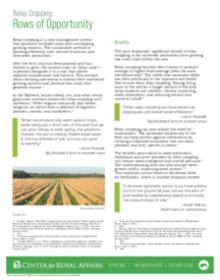Oprima aquí para la versión en español.
Relay cropping is a crop management system that produces multiple crops with overlapping growing seasons. The sustainable method of planting efficiently uses natural resources and diversifies production.
After the first crop has been planted and has started to grow, the second crop—or “relay crop”— is planted alongside it in a way that allows separate maintenance and harvest. This method allows farming operations to extend their traditional growing seasons and produce two crops that generate income.
In the Midwest, winter wheat, rye, and other cereal grains are common choices for relay cropping with soybeans. Other regions commonly pair wheat, sorghum, or cotton with a selection of legumes, potatoes, canola, and sunflowers.
“When we produce only warm season crops, we’re using just a short part of the year that we can grow things. In early spring, the ground is thawed, the sun is shining, there’s liquid water in the top 4 inches of soil, and you can grow something.” –Jason Russell, Big Boulder Farms in eastern Iowa


